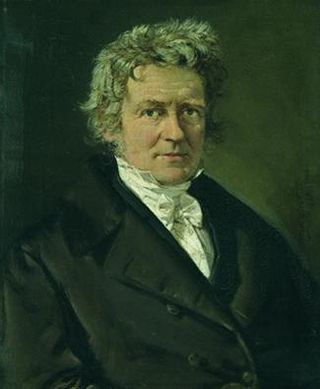
Friedrich Wilhelm Bessel was a German astronomer, mathematician, physicist, and geodesist. He was the first astronomer who determined reliable values for the distance from the sun to another star by the method of parallax. Certain important mathematical functions were named Bessel functions after Bessel's death, though they had originally been discovered by Daniel Bernoulli before being generalised by Bessel.

The history of astronomy focuses on the contributions civilizations have made to further their understanding of the universe beyond earth's atmosphere. Astronomy is one of the oldest natural sciences, achieving a high level of success in the second half of the first millennium. Astronomy has origins in the religious, mythological, cosmological, calendrical, and astrological beliefs and practices of prehistory. Early astronomical records date back to the Babylonians around 1000 BCE. There is also astronomical evidence of interest from early Chinese, Central American and North European cultures.

Areography, also known as the geography of Mars, is a subfield of planetary science that entails the delineation and characterization of regions on Mars. Areography is mainly focused on what is called physical geography on Earth; that is the distribution of physical features across Mars and their cartographic representations. In April 2023, The New York Times reported an updated global map of Mars based on images from the Hope spacecraft. A related, but much more detailed, global Mars map was released by NASA on 16 April 2023.
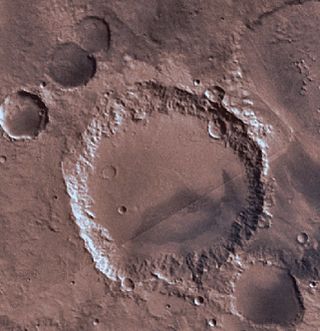
Beer is a crater lying situated within the Margaritifer Sinus quadrangle (MC-19) region of the planet Mars, named in honor of the German astronomer, Wilhelm Beer. It is located at 14.4°S 351.8°E.

Mädler is a crater on Mars. It was named in honor of the German astronomer Johann Heinrich Mädler by the IAU in 1973.

William Henry Pickering was an American astronomer. Pickering constructed and established several observatories or astronomical observation stations, notably including Percival Lowell's Flagstaff Observatory. He led solar eclipse expeditions and studied craters on the Moon, and hypothesized that changes in the appearance of the crater Eratosthenes were due to "lunar insects". He spent much of the later part of his life at his private observatory in Jamaica.
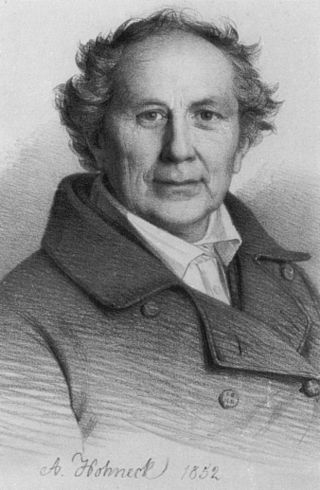
Friedrich Wilhelm August Argelander was a German astronomer. He is known for his determinations of stellar brightnesses, positions, and distances.

Frederik Kaiser was a Dutch astronomer. He was director of the Leiden Observatory from 1838 until his death.
George Phillips Bond was an American astronomer. He was the son of William Cranch Bond. Some sources give his year of birth as 1826.

Johann Heinrich von Mädler was a German astronomer.
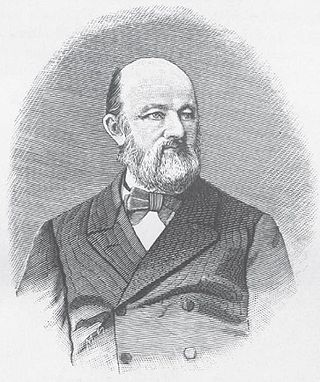
Johann Friedrich Julius Schmidt was a German astronomer and geophysicist. He was the director of the National Observatory of Athens in Greece from 1858 to 1884. Julius Schmidt was tireless in his work, it was suggested by William Henry Pickering that he perhaps devoted more of his life than any other man to the study of the Moon. During his lifetime, he made some of the most complete lunar maps of the 19th century.
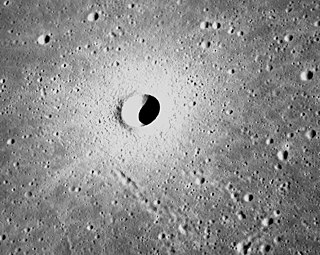
Linné is a small lunar impact crater located in the western Mare Serenitatis. It was named after Swedish botanist Carl Linnaeus. The mare around this feature is virtually devoid of other features of interest. The nearest named crater is Banting to the east-southeast. The estimated age of this copernican crater is only a few tens of millions of years. It was earlier believed to have a bowl shape, but data from the LRO showed that it has a shape of a flattened, inverted cone. The crater is surrounded by a blanket of ejecta formed during the original impact. This ejecta has a relatively high albedo, making the feature appear bright.

Eratosthenes crater is a relatively deep lunar impact crater that lies on the boundary between the Mare Imbrium and Sinus Aestuum mare regions. It forms the western terminus of the Montes Apenninus mountain range. It is named after ancient Greek astronomer Eratosthenes of Cyrene, who estimated the circumference of the Earth, and the distance from the Earth to the Sun.
A peak of eternal light (PEL) is a hypothetical point on the surface of an astronomical body that is always in sunlight. Such a peak must have high latitude, high elevation, and be on a body with very small axial tilt. The existence of such peaks was first postulated by Beer and Mädler in 1837. The pair said about the lunar polar mountains: "...many of these peaks have eternal sunshine". These polar peaks were later mentioned by Camille Flammarion in 1879, who speculated that there may exist pics de lumière éternelle at the poles of the Moon. PELs would be advantageous for space exploration and colonization due to the ability of an electrical device located there to receive solar power regardless of the time of day or day of the year, and the relatively stable temperature range.
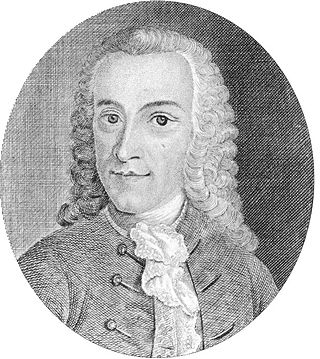
Tobias Mayer was a German astronomer famous for his studies of the Moon.

The classical albedo features of Mars are the light and dark features that can be seen on the planet Mars through an Earth-based telescope. Before the age of space probes, several astronomers created maps of Mars on which they gave names to the features they could see. The most popular system of nomenclature was devised by Giovanni Schiaparelli, who used names from classical antiquity. Today, the improved understanding of Mars enabled by space probes has rendered many of the classical names obsolete for the purposes of cartography; however, some of the old names are still used to describe geographical features on the planet.

The National Observatory of Athens is a research institute in Athens, Greece. Founded in 1842, it is the oldest research foundation in Greece. The Observatory was the first scientific research institute built after Greece became independent in 1829, and one of the oldest research institutes in Southern Europe. It was built around the same period as the United States Naval Observatory.

Selenography is the study of the surface and physical features of the Moon. Like geography and areography, selenography is a subdiscipline within the field of planetary science. Historically, the principal concern of selenographists was the mapping and naming of the lunar terrane identifying maria, craters, mountain ranges, and other various features. This task was largely finished when high resolution images of the near and far sides of the Moon were obtained by orbiting spacecraft during the early space era. Nevertheless, some regions of the Moon remain poorly imaged and the exact locations of many features are uncertain by several kilometers. Today, selenography is considered to be a subdiscipline of selenology, which itself is most often referred to as simply "lunar science." The word selenography is derived from the Greek word Σελήνη and γράφω graphō, meaning to write.

The history of Mars observation is about the recorded history of observation of the planet Mars. Some of the early records of Mars' observation date back to the era of the ancient Egyptian astronomers in the 2nd millennium BCE. Chinese records about the motions of Mars appeared before the founding of the Zhou dynasty. Detailed observations of the position of Mars were made by Babylonian astronomers who developed arithmetic techniques to predict the future position of the planet. The ancient Greek philosophers and Hellenistic astronomers developed a geocentric model to explain the planet's motions. Measurements of Mars' angular diameter can be found in ancient Greek and Indian texts. In the 16th century, Nicolaus Copernicus proposed a heliocentric model for the Solar System in which the planets follow circular orbits about the Sun. This was revised by Johannes Kepler, yielding an elliptic orbit for Mars that more accurately fitted the observational data.

Burton is an impact crater in the Memnonia quadrangle of Mars. It is 123.0 km in diameter and was named after British astronomer Charles E. Burton; the name was approved in 1973.


















